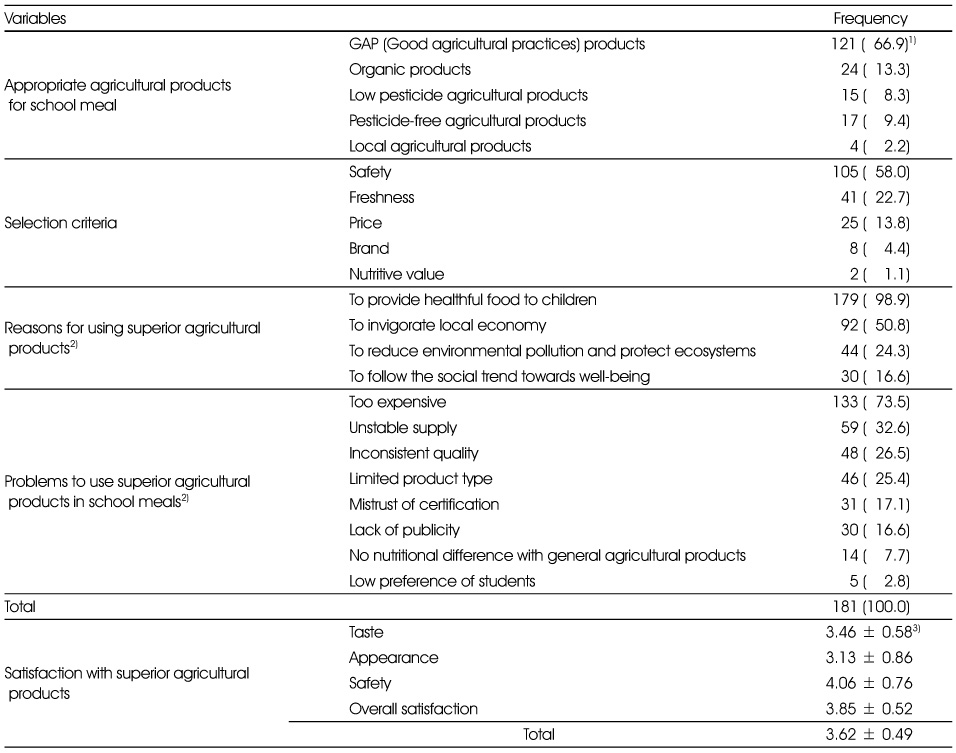References
1. Baek SW, Song CH. The plan for the food supply system in school food service for the consumption extension of agricultural products. Korean J Food Mark Econ 2005. 22(2)113–134.
2. Choi MK, Seo HC, Baek SH. The influence of environment-friendly agricultural products(EAPs) perception of parents in Chung-buk area on EAPs consumption behavior. Korean J Food Nutr 2010. 23(2)269–275.
3. Heo SW. Development process and strategies for school lunch program using envionmentally friendly agri-products. Korean J Org Agric 2006. 14(1)41–53.
4. Hong KW, Kim HC, Lee JT. The analysis of economic effects of school foodservice using the input-output analysis-a case of elementary school foodservice at Naju city, Cheonnam province-. J Korean Acad Ind Coop Soc 2010. 11(10)3747–3755.
5. Kang HY, Jung EH, Rhie SG. Food materials for school foodservices on high-quality products, local products and fresh-cut products -Dietitian's choice in elementary, middle and hgh schools in Gyeong-gi province-. Korean J Community Living Sci 2009. 20(3)397–411.
6. KDA. Foodservice management manual 2 2007. Seoul: The Korean Dietetic Association; 57–107.
7. Kim EJ. The perception and utilization on the excellent agricultural products of elementary school dietitians in Daegu and Gyeongbuk area 2008. Daegu University; MS thesis.
8. Kim H, Heo SW, Oh HY. A system and estimated costs of school lunch program using environmentally friendly agriproducts. Korean J Food Mark Econ 2006. 23(1)33–51.
9. Kim HK, Kim JH. Comparison of awareness and practice on well-being life and related behaviors according to generations. Korean J Community Nutr 2007. 12(4)426–439.
10. Kim NR, Cho YS, Kim SA. Satisfaction and recognition level of environment-friendly agricultural products in Cheongju area. Korean J Community Nutr 2011. 16(1)75–85.
11. Lee JE, Heo SW. An analysis on the satisfaction and additional cost scale of environmental-friendly agri-product school meal program. Korean J Org Agric 2005. 13(2)145–159.
12. Lee KE. Requirements and self-evaluation of competencies necessary to be effective nutrition teachers perceived by school food service dieticians. J Korean Soc Food Sci Nutr 2009b. 38(5)626–635.
13. Lee YJ. Evaluation of the effects on food service quality and food purchasing attitudes according to the LOHAS level of school foodservice employees. Korean J Food Cookery Sci 2009a. 25(5)564–574.
14. Lee YS, Lee NO, Ko SH. A survey on use of environment-friendly agricultural products for school food service by dietitians in Chungnam province. Korean J Community Nutr 2009. 14(5)556–564.
15. Lee YS, Park MJ. Parental perception and satisfaction with environment-friendly agricultural products used for school foodservice in elementary schools in Daejeon. Korean J Food Cult 2008. 23(6)737–747.
16. Ministry of Educational Science and Technology. Instructions for school health and foodservice 2010 2010a. Seoul: Ministry of Educational Science and Technology; 35.
17. Ministry of Educational Science and Technology. Instructions for school health and foodservice 2011 2010b. Seoul: Ministry of Educational Science and Technology; 45–46.
18. Ministry of Educational Science and Technology. Instructions for school health and foodservice 2012 2012. Seoul: Ministry of Educational Science and Technology; 27–42.
19. National Agricultural Products Quality Management Service 2011. cited 2011 April 7.
http://www.naqs.go.kr/.
20. Rho JO, Kim MO. A study on the utilization, recognition, and satisfaction of environment-friendly agricultural products in school food services according to the type of food service in Jeonbuk area. Korean J Hum Ecol 2011. 20(2)427–437.
21. Ryu K, Woo CN, Kim WJ. Assessment of dietitian's nutritional quality management for school food service. J Korean Soc Food Sci Nutr 2006. 35(2)238–247.
22. Sung MJ, Choi HS, Chang KJ. Perceptions on environment and environment-friendly agricultural products of college students in Seoul and Incheon area. J Korean Soc Food Sci Nutr 2008. 37(3)317–324.
23. Yang IS, Lee BS, Lee SJ, Lee HY, Jung HY. Using status of Korean agricultural products in school food service and dieticians' perception. Korean J Food Cult 2006. 21(2)142–153.






